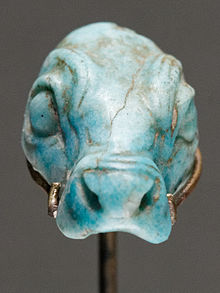
Back كادشمان تورغو Arabic كادشمان تورجو ARZ Kadaixmanturgu Catalan Kadašman-Turgu Czech Kadašman-Turgu German Kadashman-Turgu Spanish Kadashman-Turgu Basque کاداشمان-تورگو Persian Kadashman-Turgu French Kadashman-turgu Dutch
| Kadašman-Turgu | |
|---|---|
| King of Babylon | |
 Zoomorph amulet[i 1] with an inscription in the name of Kadashman-Turgu, Louvre Museum | |
| Reign | c. 1281–1264 BC |
| Predecessor | Nazi-Maruttaš |
| Successor | Kadašman-Enlil II |
| House | Kassite |
Kadašman-Turgu, inscribed Ka-da-aš-ma-an Túr-gu and meaning he believes in Turgu, a Kassite deity, (1281–1264 BC short chronology) was the 24th king of the Kassite or 3rd dynasty of Babylon. He succeeded his father, Nazi-Maruttaš, continuing the tradition of proclaiming himself “king of the world”[1] and went on to reign for eighteen years.[i 2] He was a contemporary of the Hittite king Ḫattušili III, with whom he concluded a formal treaty of friendship and mutual assistance, and also Ramesses II with whom he consequently severed diplomatic relations.
Kadašman-Turgu reigned during momentous times, but seems to have played only a peripheral role. Ḫattušili III, in a letter[i 3]: r52 to his son and successor Kadašman-Enlil II, said of him, “they used to call [your father] a king who prepares for war but then stays at home”.[2][3] His personal seal[i 4] included suckling animals in two registers, allegorically symbolizing his care for his subjects.[4] The continued employment of the extinct Sumerian language in royal votive inscriptions was in decline and the Babylonian calendar was under revision[5] with the introduction of the Akkadian term: Šanat rēš šarrūti, “accession year.”[i 5][6]
Cite error: There are <ref group=i> tags on this page, but the references will not show without a {{reflist|group=i}} template (see the help page).
- ^ J. A. Brinkman (1976). Materials for the Study of Kassite History, Vol. I. Oriental Institute of the University of Chicago. pp. 162, 164.
- ^ J. M. Munn-Rankin (1975). "XXV: Assyrian Military Power, 1300–1200 BC, The Campaigns of Adad-Nīrāri I". In I. E. S. Edwards; C. J. Gadd; N. G. L. Hammond; S. Solberger (eds.). The Cambridge Ancient History, Volume II, Part 2, History of the Middle East and the Aegean Region, 1380–1000 BC. Cambridge University Press. p. 277. if the passage has been “correctly restored”.
- ^ Ulla Koch-Westenholz (2000). Babylonian Liver Omens: The Chapters Manzazu, Padanu, and Pan Takalti of the Babylonian Extispicy Series Mainly from Assurbanipal's Library. Museum Tusculanum. p. 191. footnote 544.
- ^ Gisela Stiehler-Alegria (2003). "Das Kadasman-Turgu-Siegel VAT 9672 Aus Dem Tiglat-Pileser Archiv Von Assur: Die Allegorie Des ""saugenden Muttertieres" Als Bildprogramm Von Kadasman-Turgu Bis Adad-Suma-Iddina". Isimu: Revista sobre Oriente Próximo y Egipto en la antigüedad (6). Universidad Autónoma de Madrid: Facultad de Filosofía y Letras. Centro Superior de Estudios de Asiriología y Egiptología: 295–308.
- ^ J. A. Brinkman (1999). "Kadašman-Turgu". In Dietz Otto Edzard (ed.). Reallexikon Der Assyriologie Und Vorderasiatischen Archaologie: Ia – Kizzuwatna (Volume 5). Walter De Gruyter. p. 286.
- ^ J. A. Brinkman (1971). "Mu-ús-sa Dates in the Kassite Period". Die Welt des Orients. 6 (2). Vandenhoeck & Ruprecht: 153–156. JSTOR 25682694.